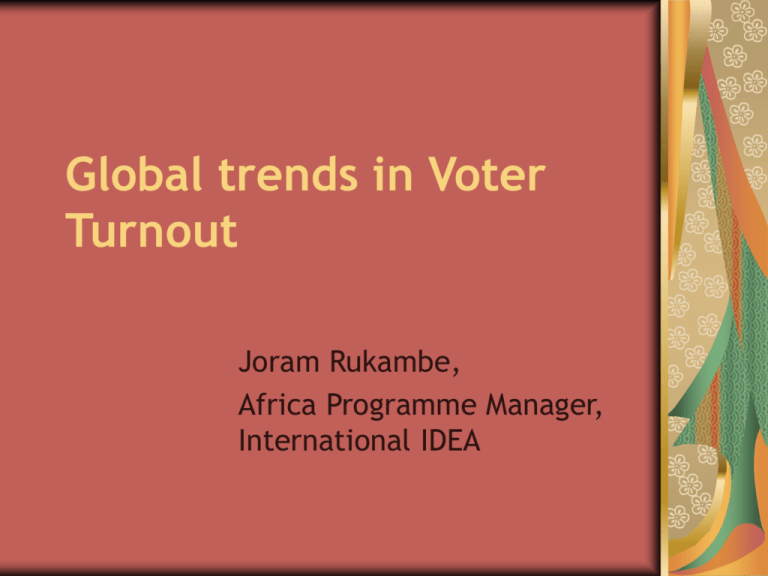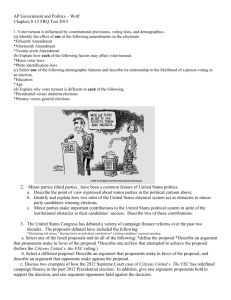Global Trends in Voter Turnout
advertisement

Global trends in Voter Turnout Joram Rukambe, Africa Programme Manager, International IDEA Objectives of the Presentation Highlight key trends in voter turnout and participation at the global level Presentation based on research done by International IDEA on voter turnout world wide: 1945-2001 Key sources include IDEA database on voter turnout (2002); The Global Report on Voter Turnout (2002); and the regional follow-up for Western Europe (2004) – see www.idea.int Introduction The 20th and 21th centuries saw increased enfranchisement of voters across geographical, racial, socio-economic and gender divides The 1970s – 1990s saw globalization of democracy - the ‘third wave of democracy’ Independence & Democracy increased democratic countries from 27 % in 1970 to 62% in 2000 (Freedom House). More avenues for political participation TODAY than EVER before Direct Democracy Citizen’s initiatives Recalls Referenda Lobbying and media debates Elections: Supranational National (federal/central) State (provincial/regional) Local/district/municipal/ canton Civic and other community-based (traditional & religious) forums: (Khotla) Reality check 2004 saw more people voting than ever before in the history of mankind US, Ukraine, Indonesia, Afghanistan, India, etc. European Parliament South Africa Botswana Namibia Mozambique Regional trends in voter turnout: 1990 - 2001 Eastern Europe 72% Western Europe 78% North, Central, and Southern America, Caribbean 65% Oceania (Pacific and Australia) 79% Africa 64% Regional trends cont. Western Europe Liechtenstein (17) 92% Belgium (18) 92.5% N-America and Caribbean Bahamas (6) 91% Canada (18) 73% Oceana Australia (22) 94% New Zealand (19) 92% Africa Burundi (1) 91% Angola (1) 91% Mauritius (7) 82% South Africa, Malawi, Namibia, Mozambique Correlation between democratic consolidation and voter turnout? Slow and steady decline in voter turnout since the 1980s Voter apathy is across all regions: older and newer, and smaller and larger democracies. World Wide Turnout: 1945 - 2001 Voter Turnout decline over time FOUNDING AND SUBSEQUENT ELECTIONS BY REGION Voter Apathy is more pronounced among: Young voters High-income voters Diaspora voters Increased access to information and education among women has reduced the ‘gender gap’ in voting since 1980 Factors influencing electoral participation Socio-political factors Institutional/systemic factors Mechanical/Procedura l factors Other factors Socio-political Factors Bad governance: scandals, lack of transparency and accountability Voter distrust of political and electoral processes: ‘elections will always be stolen’ Literacy rate Gerrymander Lack of viable alternative to the incumbent: ‘when elections are over before they start’ Social exclusion and political disenfranchisement: women, nonnationals, young voters, absentee voters Systemic Factors Electoral system: PR yield higher voter turnout compared to FPTP, unless in close-result constituencies Voting age constraint: lowering to 16? Allowing non-national to vote, especially in local elections? Compulsory vs. voluntary registration and voting: pros and cons Systemic Factors Party-systems: multiparty systems tend to encourage high turnout, especially if each vote counts and is not be ‘wasted’ Election dates: holiday season - Dec 26th! rainy season? Mechanical factors Access to voter registration and voting: time and distance Access to information and education on democracy, elections, and voting Several day voting [Mozambique, Namibia] Declaring voting day a public holiday, or voting during the weekend Voter fatigue. ‘Yoked elections? Easy access to registration and voting for PLDs: Braille & wheelchair-friendly venues Mechanical factors Automation of key electoral processes (making it easy): Voter registration [state initiated & continuous] Voting Counting Access to election dispute resolution mechanisms, including alternative dispute resolution mechanisms (party liaison structures) Other Factors which affect electoral participation EMB independence and competence: How members are appointed and operate Staff skills and competence EMB financial and operational autonomy EMB stakeholder management capacity Public trust and confidence in political and electoral processes The EMB must work hard to make this possible – ‘making the impossible possible’ Conclusion The process of increasing voter turnout requires a two-prong approach: Systemic reform: electoral systems and election procedures Introduction of vigorous and sustained civic and voter education campaigns to lure voters back to the polls Stakeholder participation (multi-sectoral collaboration) is critical for the success of this two-prong intervention -End-





